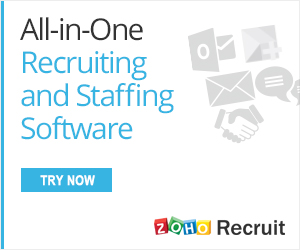A 12-step Manual for Constructing Talent Pipelines (part 1)

A special thank you goes out this month’s Leadership Sponsors: Zoho and TheLadders. Please visit their sites to understand how these quality services can elevate your recruitment practices.

Globally, around one in four employers (24%) said a general lack of experience was the root of the talent shortages they face, while nearly one in five employers (19%) believed candidates lack the required employability skills or “soft skills”. Employers noted a number of soft skills deficiencies, including enthusiasm/motivation (5%), interpersonal skills (4%), professionalism (e.g. appearance, punctuality) (4%), and flexibility and adaptability (4%).
The survey discovered that employers will most likely train and develop existing staff to alleviate talent shortage issues. They also reported that their organizations are further increasing their focus on the talent pipeline and seeking to source talent outside established talent pools.

So, to help businesses improve this function, we’ve looked to the advice of Oracle from its “Building Critical Talent Pipeline: Creating a Plan for Staffing Critical Job Roles ” whitepaper. The paper explains that critical positions can lie at the core of conducting everyday business or these types of roles can be central to long-term new product strategy. Organizations that don’t have the right people in critical jobs forfeit revenue growth, innovate more slowly, and/or lose competitive advantage because they are unable to adapt to market dynamics, the paper said.
So, what can businesses do? The paper advises to define, attract, and develop the right mix of critical talent to support and grow your company—and this begins with building critical-talent pipelines.
Key Components of Critical-talent Pipeline Construction
The paper suggests four key components of building critical-talent pipelines:
- Assessing internal and external talent pools
- Determining the gaps between available and needed talent
- Identifying the best strategies for developing and acquiring the talent to fill those gaps
- Executing, monitoring, and refining pipeline strategies
And to successfully navigate through each component, the paper lays out a 12-step methodology, or key activities that will help businesses construct each of the four parts above, when combined ultimately producing a critical-talent pipeline.
Let’s look at the first six steps:
Step 1—Determine Current and Future Needs
The paper explains that businesses must first identify and analyze critical roles before beginning to build a pool of critical talent. There are various factors you must consider when your company classifies a job role as “critical.” Determine its impact on:
- Revenue generation
- Customers
- Intellectual property
- Technical proficiency
- Execution of the business plan
Evaluate which functions deliver the highest value and which, if unfilled, have high opportunity costs and create significant organizational risk. The dual characteristics of typical critical roles are the criticality and business impact of the function, combined with the difficulty of filling the role.
Step 2—Assess the Talent Inventory
What skills and capabilities are necessary to be successful in these critical roles? The paper suggests examining the characteristics of employees who are currently successful in similar critical roles to help you answer this question.
Then once you’ve created a profile of the “ideal employee” for a critical position, Oracle advises to begin assessing employees who currently hold critical positions. Looking past skill sets and competencies, evaluate any degree of flight risk(s), typical turnover rates and preferences to develop a full picture of current and future gaps.
The profile of the ideal employee is also effective in assessing the status of internal and external candidates for critical roles. Using this profile, organizations can develop a clear picture of the number of internal and external candidates who can fill critical roles and what skills and competencies (if any) these employees would need to acquire
Step 3—Determine the Mix for Filling Gaps
Now that you’ve determined your current and future needs and have assessed your talent inventory, you’ll have the necessary information to decide whether to pursue external recruiting strategies, internal development strategies or both.
The paper lists the follow factors for determining the mix:
- State of the labor market
- Strength of the internal development infrastructure (programs and resources)
- Cultural importance of hiring from within for critical roles
- Productivity and risk of failure in the role (especially first-year retention)
Step 4—Define the Pool of Internal Candidates
As you develop internal candidates for critical positions, the paper reminds you of a valuable aspect of this process: assigning them to a specific talent pool.
Defining a pool helps HR leaders more efficiently assign development activities and monitor the progress of a group of individuals. Organizations might find it helpful to define multiple pools, based on how long it may take for groups of individuals to prepare to step into critical roles.
Step 5—Assess and Develop the Pool
The next step, according to Oracle, is to assign specific development activities to all the individuals in a pool. The purpose of these development activities is to fill in gaps for skills and competencies. Activities can range from formal classroom training to experience-based development activities, such as mentoring programs or expatriate and rotational assignments.
Step 6—Track Development Progress
There’s no point in implementing development activities if you don’t assess their impact. The paper notes that as internal candidates progress through the activities from step 5, organizations should use assessments to verify whether the assigned activities are having the expected impact on skills and competence development.
Assessment results that show that the pool as a whole is not making the expected progress may indicate development programs or specific classes that have not been structured to develop the needed skills.
We’re only halfway through the process of constructing effective talent pipelines. Stay tuned for part 2 of this article for the final six steps for full completion.
A special thank you goes out this month’s Leadership Sponsors: Zoho and TheLadders. Please visit their sites to understand how these quality services can elevate your recruitment practices.

